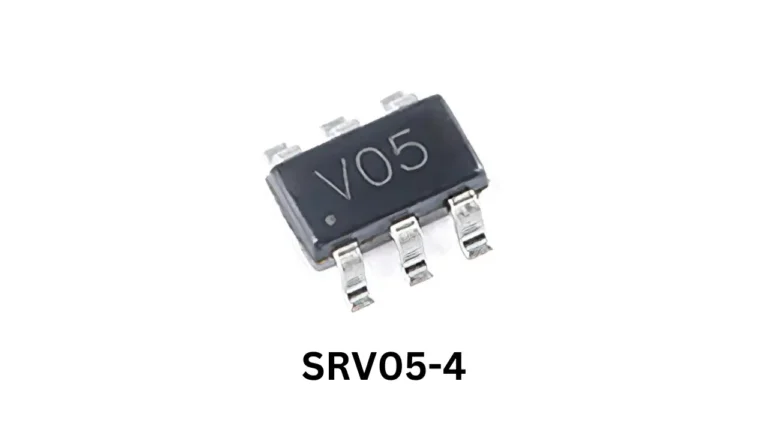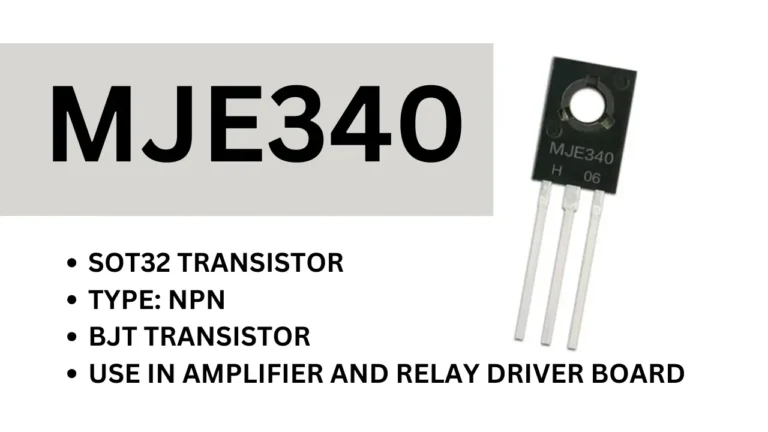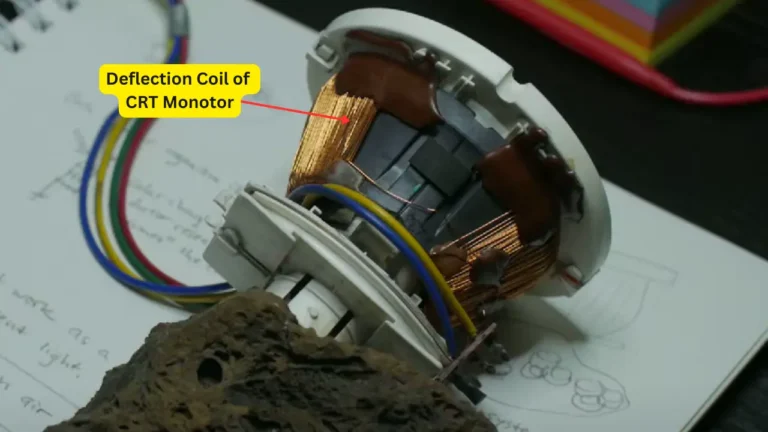ATmega328 is a microcontroller chip developed by Atmel (now owned by Microchip Technology). It is a member of the AVR (Advanced Virtual RISC) family of microcontrollers and is commonly used in a variety of electronic devices, including Arduino boards.
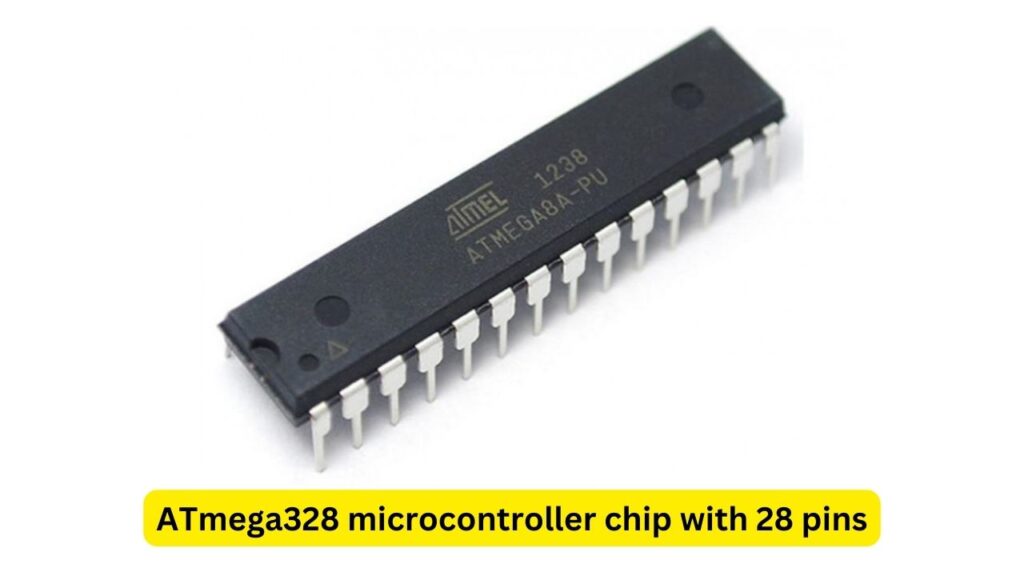
The ATmega328 has 32KB of flash memory, 2KB of SRAM, and 1KB of EEPROM, and it runs at a clock speed of up to 20 MHz. It has 23 digital input/output pins, 6 analog inputs, and some built-in peripherals, such as a UART, timers, and a 10-bit analog-to-digital converter (ADC).
The ATmega328 can be programmed using a variety of languages, including C, C++, and assembly. It is widely used by hobbyists and professionals for projects such as home automation, robotics, and Internet of Things (IoT) applications.
Atmega328 Microcontroller Features
Here are some key features of the ATmega328 microcontroller:
- 32KB of flash memory: This is used to store the program code that the microcontroller executes.
- 2KB of SRAM: This is used to store data that the program needs to access quickly, such as variables and arrays.
- 1KB of EEPROM: This is used to store data that needs to be retained even when the power is turned off, such as settings and configurations.
- 23 digital input/output pins: These pins can be configured as inputs to read digital signals from sensors or switches, or as outputs to control devices such as LEDs or motors.
- 6 analog inputs: These pins can be used to read analog signals from sensors such as temperature sensors or potentiometers.
- UART: This is a serial communication interface that can be used to communicate with other devices using a standard protocol such as RS-232 or TTL.
- Timers: The ATmega328 has several timers that can be used to generate periodic interrupts or to measure elapsed time.
- 10-bit ADC: This is an analog-to-digital converter that can be used to convert analog signals to a digital format that the microcontroller can understand.
- Operating frequency: The ATmega328 can run at a clock speed of up to 20 MHz.
- Pin-compatible with other AVR microcontrollers: The ATmega328 is pin-compatible with other AVR microcontrollers, which means that it can be used as a drop-in replacement in many cases.
Uses of Atmega328 IC
The ATmega328 microcontroller is a versatile chip that has a wide range of uses in various fields. Some examples of how the ATmega328 is used include:
- Arduino projects: The ATmega328 is the microcontroller used in many Arduino boards, such as the Arduino Uno. It is popular among hobbyists and makers for its simplicity and ease of use.
- Home automation: The ATmega328 can be used to control various devices in a smart home, such as lighting, thermostats, and security systems.
- Robotics: The ATmega328 can be used to control the motors and sensors of a robot, allowing it to navigate, detect objects, and perform tasks.
- Internet of Things (IoT) applications: The ATmega328 can be used to connect devices to the internet and communicate with other devices, enabling a wide range of IoT applications.
- Industrial control: The ATmega328 can be used to control industrial processes and machines, such as conveyor belts and factory automation systems.
- Medical devices: The ATmega328 can be used in medical devices such as glucose monitors, blood pressure monitors, and portable ECG machines.
- Consumer electronics: The ATmega328 can be used in a variety of consumer electronics, such as portable music players, e-readers, and handheld games.
- Educational projects: The ATmega328 is widely used in educational projects due to its simplicity and low cost. It is often used to teach students about microcontrollers, programming, and electronics.
Atmega328 Pinout
The ATmega328 microcontroller has a total of 28 pins, arranged in a dual-inline package (DIP). Here is a breakdown of the function of each pin:
- GND: Ground
- VCC: Supply voltage (usually 3.3V or 5V)
- RESET: Reset input 4-11. Port D (PD0-PD7): Digital input/output pins 12-19. Port B (PB0-PB7): Digital input/output pins 20-23. Port C (PC0-PC3): Digital input/output pins 24-29. Port A (PA0-PA5): Analog input/digital input/output pins
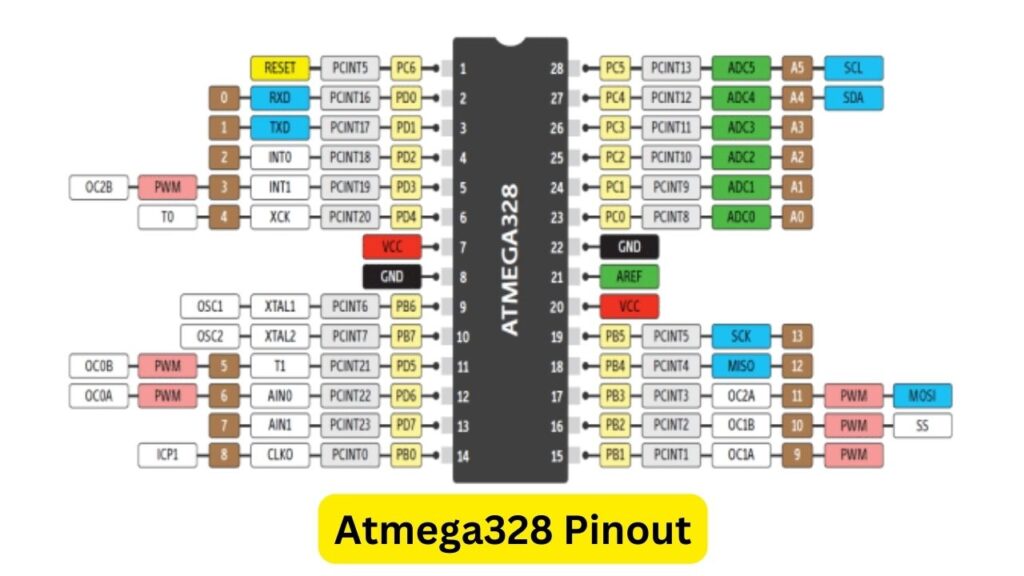
Atmega328 Pin description
The ATmega328 microcontroller has a total of 28 pins, which can be divided into the following categories:
- Power pins: There are 4 power pins: VCC, GND, AVCC, and AREF. VCC and GND are the power supply pins, while AVCC and AREF are used to provide a reference voltage for the analog-to-digital converter (ADC).
- Digital I/O pins: The ATmega328 has 23 digital input/output (I/O) pins, numbered D0 to D22. These pins can be configured as inputs to read digital signals from sensors or switches, or as outputs to control devices such as LEDs or motors.
- Analog input pins: The ATmega328 has 6 analog input pins, numbered A0 to A5. These pins can be used to read analog signals from sensors such as temperature sensors or potentiometers.
- Oscillator pins: The ATmega328 has 2 oscillator pins, XTAL1 and XTAL2, which are used to provide the clock signal for the microcontroller.
- Reset pin: The ATmega328 has a reset pin (RESET) that can be used to reset the microcontroller.
- Serial communication pins: The ATmega328 has 2 serial communication pins, RXD and TXD, which can be used to communicate with other devices using a standard protocol such as RS-232 or TTL.
- Miscellaneous pins: The ATmega328 has several miscellaneous pins, including several pins for various peripherals such as timers, a watchdog timer, and an analog comparator.


